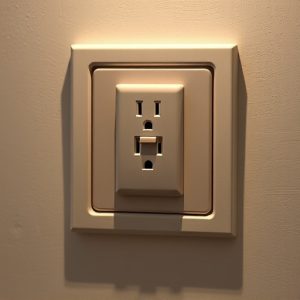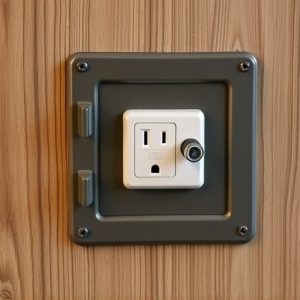Secure Storage Solutions: Installing and Concealing Your Hidden Wall Safe Outlet
The installation of a hidden wall safe outlet requires careful selection of location, adherence to …….
The installation of a hidden wall safe outlet requires careful selection of location, adherence to local electrical codes, and the expertise of a licensed electrician for safety. Two primary types of outlets are available: in-wall outlets with concealed receptacle cover plates and zero-clearance outlets that fit directly behind the safe. These options ensure the safe's appearance remains uncompromised while providing seamless integration into your home or office security system. Proper site selection involves choosing a location that is both secure and accessible for emergencies, avoiding weak spots, and using a stud finder to identify sturdy anchor points. The opening for the hidden wall safe outlet should be cut accurately to accommodate the safe and its power cord, with additional reinforcement recommended for enhanced security. The safe should then be anchored to the studs following the manufacturer's guidelines. Regular maintenance, including cleaning and voltage testing, is crucial for long-term performance and security. Upgrading options include features like surge protection and advanced locking mechanisms, which can be considered for added safety and security. A hidden wall safe outlet remains a dependable and secure storage solution when maintained and upgraded properly.
When it comes to safeguarding valuables, a hidden wall safe outlet offers discreet and secure storage solutions. This article delves into the nuances of installing a wall safe, from selecting the ideal location to understanding your outlet options. We’ll guide you through each step, ensuring your safe is both functional and concealed effectively. Whether you’re a homeowner seeking to protect important documents or an individual looking for a hidden spot for jewelry, our comprehensive guide will illuminate the process of installing your own wall safe outlet. Additionally, we’ll discuss best practices for maintaining and upgrading your installation over time to guarantee longevity and optimal performance.
Understanding Your Hidden Wall Safe Outlet Options
When installing a hidden wall safe, understanding your power supply options is crucial for seamless integration into your home or office security system. Hidden wall safe outlets are specifically designed to discreetly power your safe without compromising its stealthy appearance. These outlets are tailored to provide the necessary electrical current without protruding from the wall like standard plugs. This design maintains the sleek and hidden nature of the safe, preserving both its aesthetic appeal and security.
There are two main types of hidden wall safe outlet options available: in-wall outlets with a receptacle cover plate and zero-clearance outlets. In-wall outlets are installed within the wall cavity, leaving only a flat cover plate visible. This setup is ideal for safes that are flush against the wall, as it ensures no unsightly plugs are on display. On the other hand, zero-clearance outlets are designed to fit directly behind the safe without any additional framing or construction. They are particularly useful in retrofit installations where the safe is being added to an existing space. Both options require careful planning and adherence to local electrical codes to ensure safety and proper functionality. It’s important to consult with a licensed electrician to determine which hidden wall safe outlet option best suits your installation needs and to handle all wiring to prevent any accidents or malfunctions. With the correct setup, your hidden wall safe will remain secure and operational, safeguarding your valuables effectively.
Site Selection and Preparation for Hidden Wall Safe Installation
When installing a hidden wall safe, selecting an appropriate location and preparing the site are critical steps that ensure both security and accessibility. The ideal spot for your hidden wall safe outlet should be inconspicuous yet easily reachable in an emergency. Consider areas with less foot traffic or high visibility to deter potential intruders. Ensure that the chosen location is structural sound; avoid weak spots in the wall that might compromise the integrity of the safe once installed. Measure the intended space to ensure it accommodates the dimensions of your hidden wall safe.
Proper preparation involves using the correct tools and materials to create a secure and functional outlet for your safe. Begin by marking the precise location where the safe will be installed. Use a stud finder to locate any wooden studs within the walls, as these provide a sturdy anchor point. Drill a hole for the hidden wall safe outlet, ensuring it’s sufficiently large to accommodate the provided mounting hardware. If necessary, cut a larger section of the drywall around the intended outlet area using a reciprocating saw or jigsaw. For additional security, consider reinforcing the wall with a piece of metal or hardboard behind the safe’s installation point before affixing it to the studs. This step is crucial in maintaining an impenetrable barrier against unauthorized access. Once prepared, carefully place the hidden wall safe into the outlet, securing it according to the manufacturer’s instructions, which typically involves bolting it to the adjacent studs with the included hardware.
Step-by-Step Guide to Installing a Hidden Wall Safe Outlet
When installing a hidden wall safe outlet, it’s crucial to approach the process with precision and care. Begin by selecting an appropriate location for your safe where it will not be easily discovered. Ensure that the area has sufficient space for the safe and its door to open without hindrance. Use a stud finder to locate the wooden studs within your wall, as these will provide a sturdy anchor point for securing the safe. Mark the intended placement on the wall, keeping in mind both the safe’s dimensions and the optimal position for access.
Once you’ve determined the ideal spot, create an opening slightly larger than the electrical cable plate that will house your safe’s power cord. Carefully cut through the drywall to fit the cable plate into place, securing it to the studs with screws for stability. Next, fish the power cords from the outlet box to the location where your hidden wall safe will be installed, ensuring compliance with local electrical codes and regulations. Connect the safe’s power supply to the electrical wiring, using a qualified electrician if necessary. With the power source sorted, proceed to mount the safe onto the wall, aligning it with the pre-made opening and securing it with the provided hardware. Double-check that the safe is level and properly anchored before completing the installation. Finally, conceal any wiring or excess materials for a clean, undetectable finish, ensuring your valuables are safeguarded in a discreet and secure manner.
Best Practices for Concealing Your Wall Safe Outlet
When installing a wall safe, concealment is key to safeguarding its contents and maintaining privacy. One of the best practices for hiding your wall safe outlet is to select a location that is both functional and discreet. Opt for an area where cords and power supply lines can blend seamlessly with surrounding decor or be hidden within walls during installation. Ensure the outlet is positioned in a way that it’s not readily visible or accessible to unauthorized individuals. For optimal security, consider using a smart safe that integrates with your home automation system, allowing you to control power flow remotely and adding a layer of protection against tampering.
Another important consideration for concealing your wall safe outlet is to use appropriate materials and techniques during installation. Employ non-conductive surfaces like plastic or wood around the outlet to prevent any accidental electrical shorts. Additionally, when running wires to the outlet, route them through the studs or within existing walls to keep them out of sight. Utilizing a GFCI (Ground Fault Circuit Interrupter) outlet is also recommended for added safety, as it can detect abnormal current flow and quickly cut off electrical power to prevent shocks or electrical fires. By following these best practices, you can ensure your hidden wall safe outlet is both secure and functional.
Maintaining and Upgrading Your Hidden Wall Safe Outlet Over Time
Maintaining a hidden wall safe outlet involves regular checks to ensure its optimal performance and longevity. Over time, dust and debris can accumulate within the electrical components, potentially causing issues with power supply or functionality. To prevent this, it’s advisable to clean the safe’s interior and any exposed electrical parts with a soft, dry cloth. If necessary, a lightly dampened cloth with a neutral detergent can be used, ensuring that no liquid enters the safe itself. Additionally, periodically verify the voltage output of the outlet using a multimeter to confirm it meets manufacturer specifications. This simple maintenance step helps avoid power-related malfunctions and ensures your valuables remain secure.
For those looking to upgrade their hidden wall safe outlet, consider the latest advancements in electrical safety and power delivery. Newer models may offer features such as surge protection, improved locking mechanisms, and enhanced security protocols. When planning an upgrade, take into account the compatibility with your existing safe and any changes in the safe’s position or wiring requirements. Professional installation is recommended for any upgrades to ensure that the safe continues to be a reliable and secure storage solution. Regular maintenance and timely upgrades will help your hidden wall safe outlet remain a steadfast guardian of your most valuable possessions.


